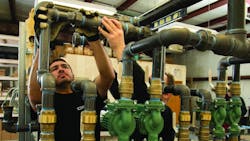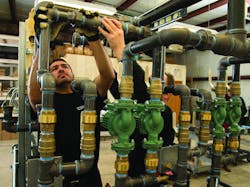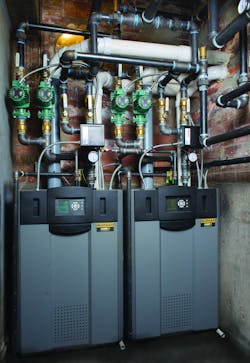Off-Site Boiler-Piping Prefab Best Solution to ‘Worst-Case Scenario’
During the fall of 2013, DRF Trusted Property Solutions was notified it had won the bid to retrofit the mechanical systems at Chatham Park Village Cooperative (CPVC) in Chicago. This was weeks after DRF thought an announcement might be made. Regardless, there was no time to waste; winter was bearing down on the city.
CPVC’s 63 buildings are World War II-era brick structures located only a few blocks from Lake Michigan. Midwinter, temperatures easily slip into the subzero range, and, it being Chicago, wind gusts are a certainty.
DRF managers ran the numbers. They knew tenants could not be without heat for more than five or six hours midwinter.
As one DRF technician said, “It was a worst-case scenario for multiple boiler replacements,” with little room for error.
Fortunately, the Plainfield, Ill.-based plumbing and mechanical contracting firm had considered the possibility of a late start and midwinter boiler replacements.
With room on site severely limited, DRF’s plan called for off-site prefabrication of near-boiler piping with all key hydronic parts and pieces. DRF settled on warehouse space at its main hydronics shop 45 miles from CPVC. There, with production-line precision, many boilers were fitted with all near-boiler piping, pumps, and valves two to four units at a time. As soon as a van could be loaded with three or four assembled “rigs,” it was bound for CPVC, where deliveries were made to separate installation teams.
Out With the Old
Life at CPVC with the old gas-fired cast-iron boilers was not one of comfort. Poorly sized and literally falling apart at the seams, the old boilers were constantly short cycling, some days at a rate of seven to 10 times per hour. Operational efficiency had fallen to less than 50 percent. Naturally, the systems were consuming inordinate amounts of fuel.
The idea was to allow the old systems to provide what heat they could while their replacements were being prepared for active duty.
To meet domestic-water-heating needs, 84 modulating-condensing Laars NeoTherm hydronic boilers with thermal efficiencies exceeding 95 percent were paired with 60-gal. Laars-Stor indirect water heaters.
Compact in size, the new boilers were maneuvered into tight spaces within the many mechanical rooms easily. They were rigged for operation while the old boilers groaned and heaved through their last living moments.
The time for fuel, supply, and return lines to the old boilers to be severed and the new systems activated was four to eight hours. During those critical daylight hours, the buildings were able to retain their heat so that temperature drops never were an issue.
Because of the urgency of meeting heating needs at CPVC, DRF turned to Romeoville, Ill.-based manufacturers’ representative and custom manufacturer Metropolitan Industries Inc.
“We prepared 19 fully assembled split-skid boiler packages to further reduce downtime at the apartments,” Matt Brickey, commercial sales associate, Metropolitan Industries, said.
Tight Schedule
Apartment owners were notified 72 hours in advance of work on a mechanical room.
The day before a system was scheduled for installation, a prefabrication team would prepare the pre-assembled mechanical arrangements and make any needed modifications for specific boiler rooms.
On the day of an installation, a demolition team would arrive by 8 a.m. and immediately cut out and remove the old boiler and components. Then, an installation team would arrive with the new equipment. By 2 or 3 p.m., the installation would be complete and heat restored.
“No one ever said, ‘We’re tired,’ ‘We’re cold,’ or, ‘We don’t have a part.’ We promised to get the job done by the end of the day, so that’s what we did,” Scott Schnurr, DRF’s chief executive officer, said.
In the assembly area, after the near-boiler piping, including air and dirt separators and pumps, was fabricated, it was moved aside and labeled for the installation crews.
Forty-two of the apartment buildings were equipped with a total of 84 boilers—all 150-MBH systems—each served by two 1/8-hp Taco 0011 inline wet-rotor circulators. Nineteen of the buildings were equipped with a total of 38 boilers—all 285-MBH systems—each served by two 1/6-hp Taco 0013 circulators. The remaining two apartment buildings were equipped with a total of four boilers—all 500-MBH systems—each served by two 1/6-hp high-capacity Taco Model 2400 pumps.
“We work with Taco a lot,” Schnurr said. “The pumps and circs are reliable and have never been the source of callbacks for us. Also, Laars chose Taco as the OEM pumps for their boilers.”
Executing the Plan
CPVC is a not-for-profit housing complex owned and operated by its members. Each member has a say in all important decisions. This rule-by-committee arrangement posed a few challenges for DRF.
“We had to look at all of the mechanical rooms and factor in pleas from the different cooperative members as to why their mechanical room should be serviced first,” Schnurr explained. “With winter moving in fast, we had to decide which of the apartments were most in need of boiler replacements. We had to create the schedule and stick with it.”
2013-14 was the coldest and second-snowiest winter in Chicago history. The brick-and-plaster apartments do not have a lot of insulation, so heat loss was an issue.
Sixteen people were involved in the project, including two two-man teams handling demolition and installation at CPVC and four people back at DRF headquarters prefabricating the assemblies. As many as three mechanical rooms were being worked on at a time.
All venting was precut. Piping, shutoff valves, and all other components were pre-assembled. With just enough space in the mechanical rooms for a two-person crew, installers arrived on site with all of the pre-fitted gear. They quickly made the necessary connections for venting, system loops, gas, and electricity.
Depending on traffic and the weather, it took technicians 45 minutes to three hours to travel from the prefabrication site to CPVC.
Benefits
“The low-NOx NeoTherms meet Energy Star’s ‘most-efficient’ specs, exceeding current government requirements,” Schnurr said.
And with their onboard outdoor reset, the new boilers respond immediately to changes in Chicago’s weather.
Further, the boilers “qualify for rebate and tax-credit programs—something that was a major benefit for the owners of the Chatham cooperative,” Schnurr added.
In April 2014, CPVC received $590,620 in rebates. Of that, $527,857 was from installation of the Laars NeoTherm boilers.
SIDEBAR: Whatever It Takes
DRF crew members learned to carry hand warmers with them at all times and have several thermoses of hot coffee and tea readily available. They even had several space heaters to warm mechanical rooms and apartments while installations were taking place.
Four members of the co-op provide maintenance for the 63 buildings. When the maintenance workers were unable to get to where they needed to be in time to remove snow, the DRF crews would handle snow removal themselves to stay on schedule. Each DRF truck had several shovels and bags of salt.
For Design Solutions author guidelines, call Scott Arnold, executive editor, at 216-931-9980, or write to him at [email protected].


